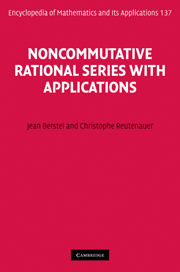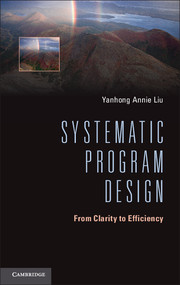Refine search
Actions for selected content:
5849 results in Programming Languages and Applied Logic
4 - Definability, unification and matching
- from Part I - Simple Types λA→
-
-
- Book:
- Lambda Calculus with Types
- Published online:
- 05 August 2013
- Print publication:
- 20 June 2013, pp 192-242
-
- Chapter
- Export citation
Indices
-
- Book:
- Lambda Calculus with Types
- Published online:
- 05 August 2013
- Print publication:
- 20 June 2013, pp 814-814
-
- Chapter
- Export citation
6 - Applications
- from Part I - Simple Types λA→
-
-
- Book:
- Lambda Calculus with Types
- Published online:
- 05 August 2013
- Print publication:
- 20 June 2013, pp 323-376
-
- Chapter
- Export citation
Index of terms
- from Indices
-
- Book:
- Lambda Calculus with Types
- Published online:
- 05 August 2013
- Print publication:
- 20 June 2013, pp 815-822
-
- Chapter
- Export citation
Index of Citations
- from Indices
-
- Book:
- Lambda Calculus with Types
- Published online:
- 05 August 2013
- Print publication:
- 20 June 2013, pp 823-827
-
- Chapter
- Export citation

Noncommutative Rational Series with Applications
-
- Published online:
- 05 June 2013
- Print publication:
- 14 October 2010

Systematic Program Design
- From Clarity to Efficiency
-
- Published online:
- 05 June 2013
- Print publication:
- 20 May 2013
Acknowledgements
-
- Book:
- Nominal Sets
- Published online:
- 05 July 2013
- Print publication:
- 30 May 2013, pp xiii-xiv
-
- Chapter
- Export citation
1 - Permutations
- from PART ONE - THEORY
-
- Book:
- Nominal Sets
- Published online:
- 05 July 2013
- Print publication:
- 30 May 2013, pp 13-28
-
- Chapter
- Export citation
0 - Introduction
-
- Book:
- Nominal Sets
- Published online:
- 05 July 2013
- Print publication:
- 30 May 2013, pp 1-10
-
- Chapter
- Export citation
6 - Equivalents of Nom
- from PART ONE - THEORY
-
- Book:
- Nominal Sets
- Published online:
- 05 July 2013
- Print publication:
- 30 May 2013, pp 95-110
-
- Chapter
- Export citation
Frontmatter
-
- Book:
- Nominal Sets
- Published online:
- 05 July 2013
- Print publication:
- 30 May 2013, pp i-iv
-
- Chapter
- Export citation
8 - Nominal algebraic data types
- from PART TWO - APPLICATIONS
-
- Book:
- Nominal Sets
- Published online:
- 05 July 2013
- Print publication:
- 30 May 2013, pp 129-152
-
- Chapter
- Export citation
PART ONE - THEORY
-
- Book:
- Nominal Sets
- Published online:
- 05 July 2013
- Print publication:
- 30 May 2013, pp 11-12
-
- Chapter
- Export citation
9 - Locally scoped names
- from PART TWO - APPLICATIONS
-
- Book:
- Nominal Sets
- Published online:
- 05 July 2013
- Print publication:
- 30 May 2013, pp 153-176
-
- Chapter
- Export citation
2 - Support
- from PART ONE - THEORY
-
- Book:
- Nominal Sets
- Published online:
- 05 July 2013
- Print publication:
- 30 May 2013, pp 29-48
-
- Chapter
- Export citation
Contents
-
- Book:
- Nominal Sets
- Published online:
- 05 July 2013
- Print publication:
- 30 May 2013, pp vii-x
-
- Chapter
- Export citation
PART TWO - APPLICATIONS
-
- Book:
- Nominal Sets
- Published online:
- 05 July 2013
- Print publication:
- 30 May 2013, pp 111-112
-
- Chapter
- Export citation
References
-
- Book:
- Nominal Sets
- Published online:
- 05 July 2013
- Print publication:
- 30 May 2013, pp 257-268
-
- Chapter
- Export citation
12 - Computational logic
- from PART TWO - APPLICATIONS
-
- Book:
- Nominal Sets
- Published online:
- 05 July 2013
- Print publication:
- 30 May 2013, pp 240-256
-
- Chapter
- Export citation
